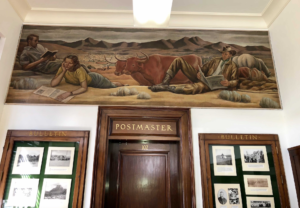
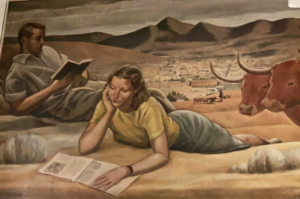
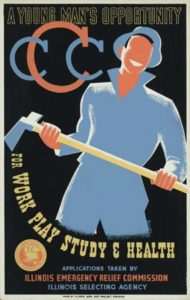
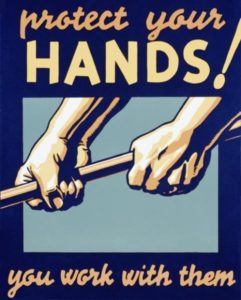 One project of “The Section” placed artists in Civilian Conservation Corps (CCC) camps to create paintings of CCC work and life, and to make safety posters and decorate camp buildings for that project. The Section even provided sculptures to be exhibited at the New York World’s Fair in 1939.
One project of “The Section” placed artists in Civilian Conservation Corps (CCC) camps to create paintings of CCC work and life, and to make safety posters and decorate camp buildings for that project. The Section even provided sculptures to be exhibited at the New York World’s Fair in 1939.
 In 1939, a Spanish-American artist Jose Moya del Pino (1891-1969) living in San Francisco entered a TDSFA competition to paint a post office mural in San Antonio. His design depicting Sam Houston and the Alamo didn’t win, but he received a consolation assignment at the new Alpine building. The sketches he submitted with a “View of Alpine” did the trick that time.
In 1939, a Spanish-American artist Jose Moya del Pino (1891-1969) living in San Francisco entered a TDSFA competition to paint a post office mural in San Antonio. His design depicting Sam Houston and the Alamo didn’t win, but he received a consolation assignment at the new Alpine building. The sketches he submitted with a “View of Alpine” did the trick that time.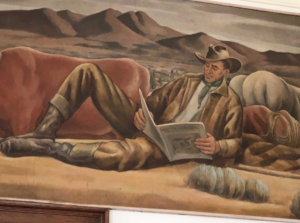
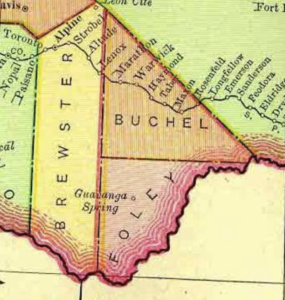 Wait . . . Buchel County? Nope, you’re not losing your marbles. There’s no Buchel County in the Lone Star State! Both Buchel and Foley Counties were absorbed into Brewster County – now the largest county in Texas – when their populations failed to flourish as well as expected.
Wait . . . Buchel County? Nope, you’re not losing your marbles. There’s no Buchel County in the Lone Star State! Both Buchel and Foley Counties were absorbed into Brewster County – now the largest county in Texas – when their populations failed to flourish as well as expected.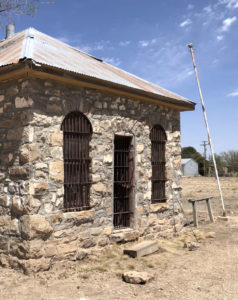
 Now this is pretty neat for fans of old-times Texas. Lucius T. Noyes was an agent for the Diebold Safe & Lock Company of Canton, Ohio. From his Houston office on the corner of Congress Avenue and San Jacinto Street he established a far reaching reputation in the world of “security.”
Now this is pretty neat for fans of old-times Texas. Lucius T. Noyes was an agent for the Diebold Safe & Lock Company of Canton, Ohio. From his Houston office on the corner of Congress Avenue and San Jacinto Street he established a far reaching reputation in the world of “security.” 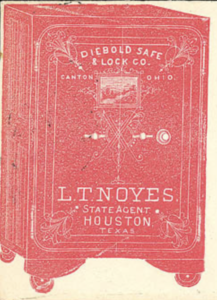
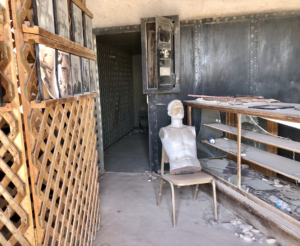 Stealing a peek through the door and windows, it looks like there might have been a museum at Marthon’s little jail at some point, and the decaying remnants are admittedly a bit creepy. That mannequin will definitely take you off guard, but you can clearly see the jail cells, photos of what are probably local lawmen of the past on the wall, and broken display cases – whose contents I can only hope were safely removed before the damage. I’d love to see this “attraction” re-opened for a closer look.
Stealing a peek through the door and windows, it looks like there might have been a museum at Marthon’s little jail at some point, and the decaying remnants are admittedly a bit creepy. That mannequin will definitely take you off guard, but you can clearly see the jail cells, photos of what are probably local lawmen of the past on the wall, and broken display cases – whose contents I can only hope were safely removed before the damage. I’d love to see this “attraction” re-opened for a closer look.